In short
|
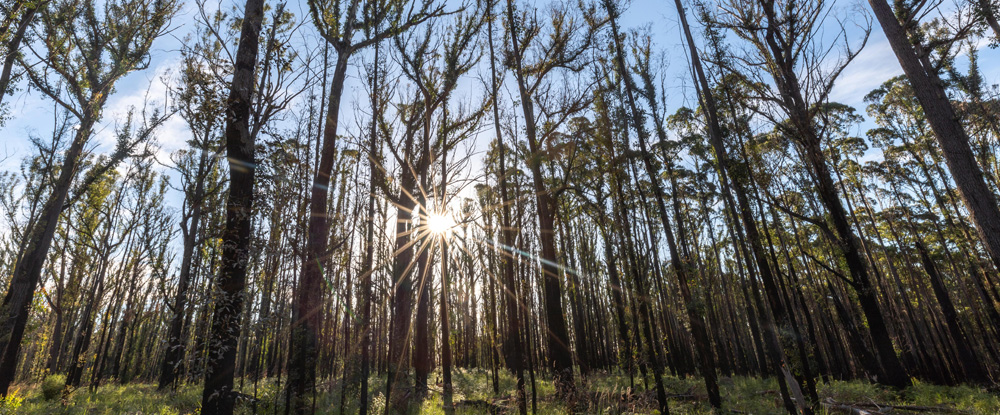
What happened
More than 1.5 million hectares of Victoria burned in the ‘Black Summer’ bushfires of 2019/20. An estimated 244 species lost more than 50% of their habitat.
This devastating loss of wildlife and habitats spurred efforts to understand the immediate threats, and undertake actions to support nature recovery.
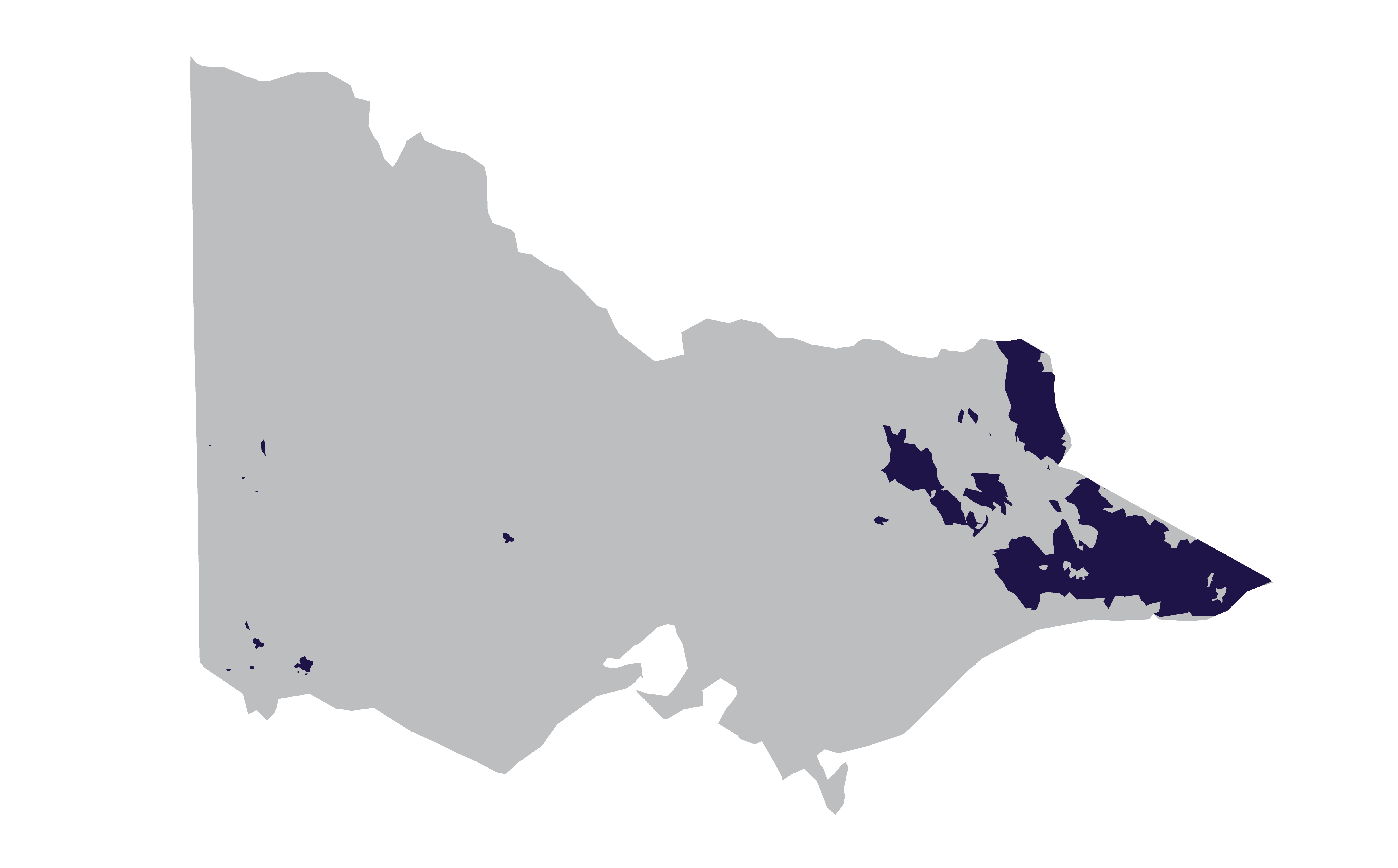
2019/20 Bushfire extent in Victoria
What we did
Once the fire grounds were safe to access, our scientists provided timely on-ground surveys of affected areas, aquatic animal rescues, analysis, modelling and guidance. This critical advice supported both government and natural resource managers across Victoria.
Recovery surveys
The Victorian Post-fire Reconnaissance Program assessed 2019/20 fire impacts on at-risk species and ecological communities. It collected information to guide management actions to prevent further declines and strengthen recovery for threatened species.
Our research focused on the key species and communities most impacted by the fires, including:
- mammals
- birds
- amphibians
- reptiles
- fish, mussels and crayfish
- native bees
- threatened flora and rainforests.
The collaborative response to the Black Summer Bushfires facilitated better resourcing of the assessments, greater sharing of data and expertise, and improved outcomes for the environment. Our partners included DEECA (formerly DELWP), Parks Victoria, Museums Victoria, Royal Botanic Gardens Victoria (RBGV), University of Melbourne, Zoos Victoria, philanthropic organisations and consultants.

Key findings:
- 108 of the 126 key plant species were successfully regenerating from seedlings or resprouts (287 sites surveyed).
- For aquatic animal species, the main impact of fires was from post-fire rainfall events, producing high sediment run-off to streams, smothering aquatic habitat and reducing water quality.
- Introduced species threatened the recovery of many threatened species studied. Problematic species include cats, foxes, pigs, rabbits, deer, willows, non-native grasses, chytrid fungus and invasive fish.
- Tree-hollow availability is a concern for the long-term recovery of arboreal mammals and large forest owls.
- Signs of Glossy Black-cockatoo feeding declined to just one-fifth of the pre-fire rates.
- Gliders were found at 57% of sites in forests of East Gippsland where they had occurred previously.
- Protection of unburnt and low severity burnt areas is a priority for many species survival.
For more information on the assessments, read the full report:
These projects were funded through the Victorian Government’s Bushfire Biodiversity Response and Early Recovery program (Phase 1).
Surveys by ARI, RBGV and volunteers, sought to understand how Victoria's threatened plant species were responding after the fires. They also studied how threats such as grazing, weed invasion, drought, or another fire could affect their recovery.
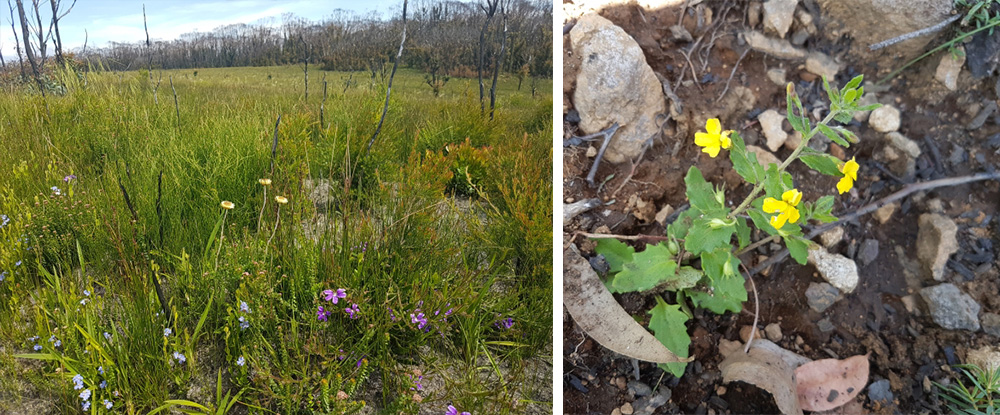
Key findings:
- Threatened plants impacted by fire should be protected from future fire and disturbance until they have matured enough to survive, regenerate and reproduce. Particularly:
- obligate seeders with long reproductive maturity periods and short-lived seeds
- resprouters with short-lived seeds that are killed by severe fire
- epiphytes such as rock orchids that lack a seedbank and are killed by fire
- Ongoing control of introduced herbivores such as deer is required to aid regeneration
- Off-site conservation may be required for some species: seed collection, seed banking, propagation and replanting.
To learn more threatened plant recovery after the fires, listen to this radio interview or view the following seminar.
For more information contact annette.muir@deeca.vic.gov.au
Around 6,300 ha (approximately 18%) of Victoria’s rainforests were burned at high severity. Led by ARI, this research investigated the effects of the bushfires on different rainforest types in eastern Victoria. Comprehensive plant surveys were undertaken across 13 rainforest sites to assess their recovery and condition. Major risks to rainforests in the post-fire period were also identified.
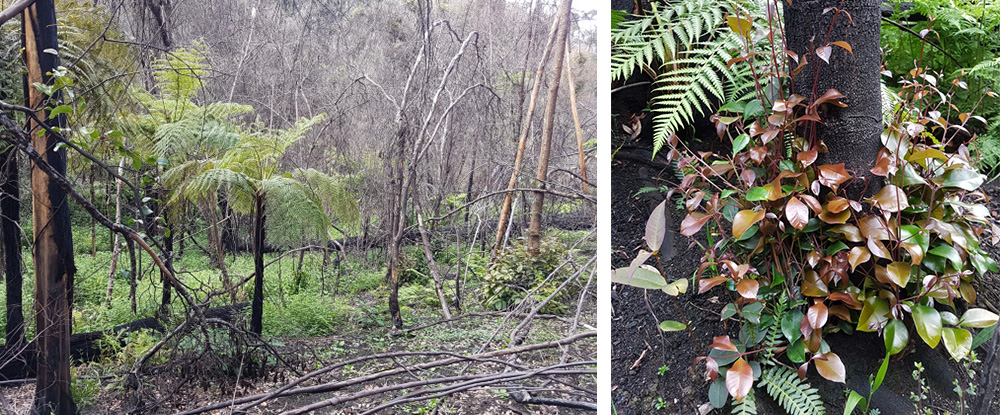
Key findings:
- Recovery of rainforest structure and species composition was strongly related to local fire severity (i.e. high fire severity led to less recovery).
- The opening up of the canopy by fire has led to prolific germination of soil-stored seed. The understorey is currently dominated by short-lived species that are less common in unburnt rainforest.
- Recruitment of eucalypts into rainforest stands may lead to long-term changes in forest structure, including reduction or loss of some rainforest stands.
- Some rainforest stands have now been burnt twice in recent decades; this has significant implications for these slow to recover communities.
The greatest long-term threat to our remaining rainforest is a warming, drying climate, which may reduce rainfall or increases in the frequency and intensity of fire.
ARI competed surveys in East Gippsland in response to desktop mapping that showed the extent and severity of the bushfires likely had substantial impacts on five high priority species:
- Southern Greater Glider (Petauroidesvolans),
- Yellow-bellied Glider (Petaurus australis)
- Powerful Owl (Ninox strenua)
- Sooty Owl (Tyto tenebricosa)
- Masked Owl (Tyto novaehollandiae)
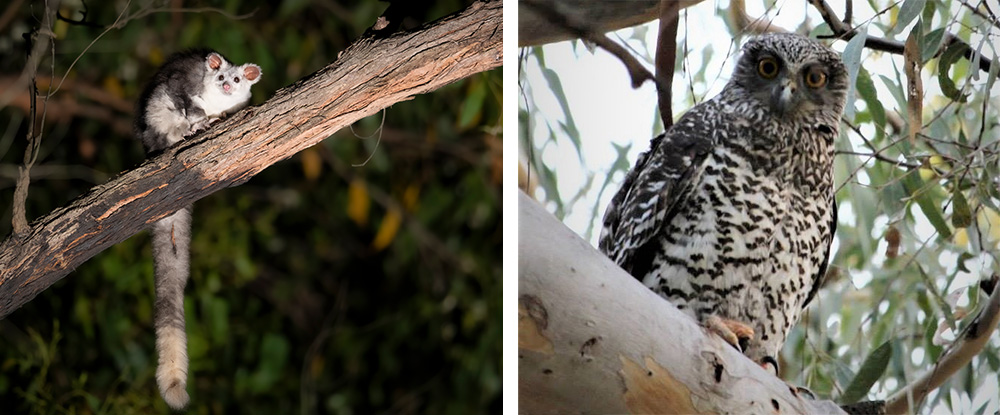
Key findings:
- Densities of Southern Greater Gliders were lower in more severely burnt habitat
- The post-fire population estimate of Southern Greater Gliders across the 1.3 million ha fire footprint is 82,000 (95% CI 55,000-120,000)
- Unburnt high-quality habitats have an important role as glider refugia from severe fire
- Gliders and large forest owls were detected more frequently in unburnt forest and forest burnt at low or medium severity, compared to forest burnt at high severity
- There were very few detections of large forest owls, making it difficult to assess the impacts of the fires on these cryptic species. However, it is possible that all the owl species have declined due to reductions in key requirements for these species (prey abundance and hollow-bearing trees)
- It is important to protect remaining unburnt forest habitat
- Retaining high numbers of hollow-bearing trees in the landscape is especially important
- Maintaining prey species in the landscape is also essential for large forest owls; protecting midstorey vegetation as shelter for prey and controlling introduced predators (such as foxes and cats)
This project was funded through the Victorian Government’s Bushfire Biodiversity Response and Recovery program (Phase 1) and the Australian Government Regional Bushfire Recovery for Multiregional Species and Strategic Projects Program.
Publications:
- Macak et al. (2023). Bushfire Recovery - Southern Greater Glider and Yellow bellied Glider.(PDF, 682.0 KB) Published Factsheet for the Australian Government. Arthur Rylah Institute for Environmental Research, Department of Environment, Land, Water and Planning, Heidelberg, Victoria. (Accessible version (DOCX, 2.7 MB))
For more information contact: jemma.cripps@deeca.vic.gov.au
Australia has over 1,700 species of native bees which are vital to functioning ecosystems, since about 88% of flowering plants need some form of pollination.
In partnership with the Melbourne Museum, we looked at the impact of the Black Summer fires by comparing bee populations within the burnt areas to adjacent unburnt locations.
- We collected more than 1100 native bees representing 67 species.
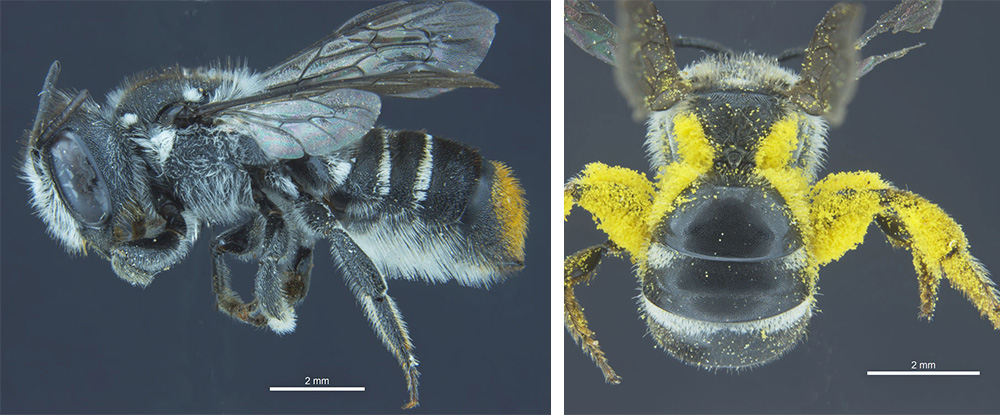
Key findings:
- The fires have initially had a negative impact on native bee populations, however the longer-term impacts are unknown.
- Of the species found, 25 species were found in burnt areas and 54 species in unburnt areas.
- Bee abundance and species richness were higher at unburnt locations.
- Most bee species found in burnt areas were collected from plants in the daisy family (Asteraceae), including exotic species.
- Bees specialising on eucalyptus and related species were not collected from burnt areas, noting that at the time of sampling, eucalypts were not yet flowering after the fires.
- Very few above-ground nesting bees were found in the burnt areas; this could be because nesting locations were destroyed by the fire or because their preferred food plants were yet to regenerate.
For more information contact matthew.bruce@deeca.vic.gov.au or david.bryant@deeca.vic.gov.au
Most reptiles and frogs have small home ranges and are unable to escape large, fast-moving fires. For many species, eastern Victoria represents a large, and often the most secure and continuous, proportion of their state distribution.
Within months of the fires, ARI completed targeted surveys for species particularly vulnerable to post-fire threats. This included species where:
- A large proportion of their known habitat was likely burnt (e.g. Gippsland Water Dragon).
- They were known to be in decline before these fires (e.g. Alpine Tree Frog).
- Burnt areas were previously considered a stronghold of their distribution (e.g. Swamp Skink).
- They have specialised habitat preferences (e.g. Alpine She-oak Skink).
- They have ecological traits that may make them particularly susceptible to impacts from fires (e.g. Lace Monitor).
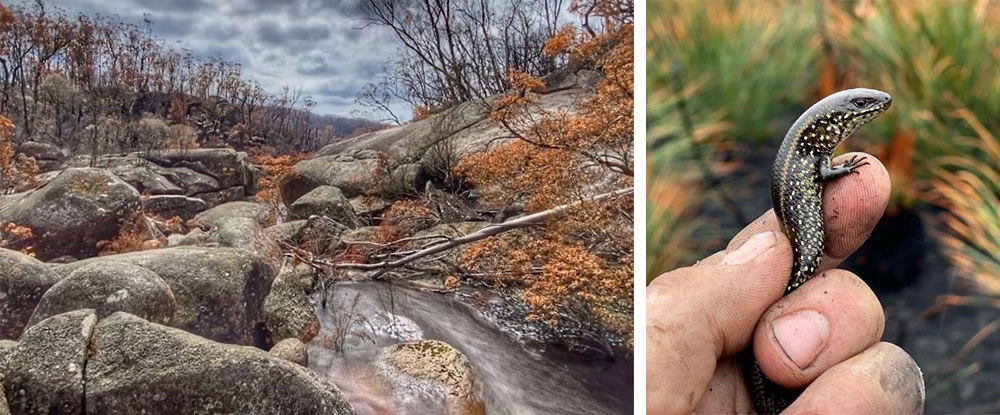
Key findings:
- Habitats that don’t usually burn easily, such as swamps, were severely damaged.
- Individuals of some species, such as Swamp Skink, were found sheltering in burrows in burnt habitat (although these may represent a small fraction of the numbers in those areas before the fires).
- Adjacent burnt and unburnt riparian habitat showed striking differences in the number of Water Dragons.
Alpine Sphagnum bogs are threatened ecological communities that provide significant benefits to the natural environment. The 2019/20 bushfires affected 537 hectares of alpine bogs, which is about 20% of their area in north-eastern Victoria.
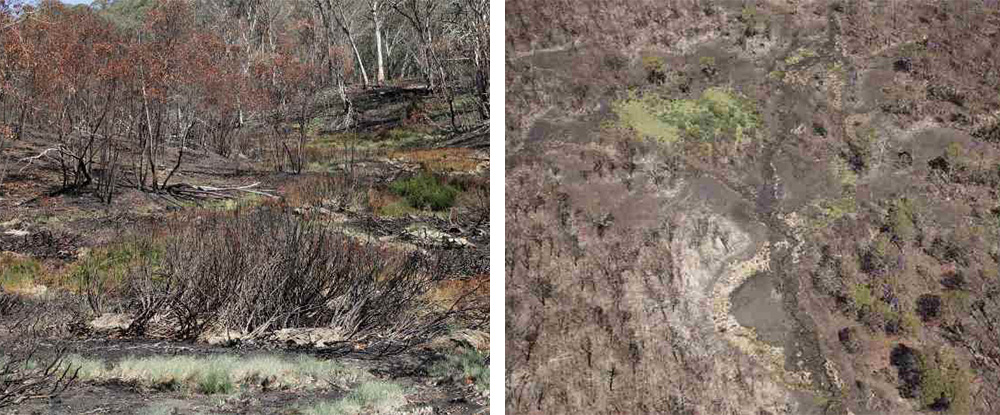
Key findings:
- Some bogs were burnt severely, and have now been burnt twice or more in recent decades.
- Severely or reburned bogs will require long periods without disturbance if they are to return to pre-fire condition and extent.
- Feral horses, deer, pigs, cattle, and willows present the greatest risks to bogs post fire.
- Without urgent management action to address these pervasive threats, many burnt bogs are likely to contract in size or disappear entirely.
Publications:
Bushfire Biodiversity Response and Recovery Program: Post-fire assessment of Alpine Bogs. (PDF, 2.8 MB) (Accessible version (DOCX, 5.7 MB))
Critically endangered Glossy Black-Cockatoo surveys were completed just before the 2019/20 bushfires as part of a separate project. ARI researchers returned to these sites looking for feeding signs indicative of species persistence. These Cockatoos feed almost exclusively on the tiny unripe seeds of the Black Sheoak, Allocasuarina littoralis.
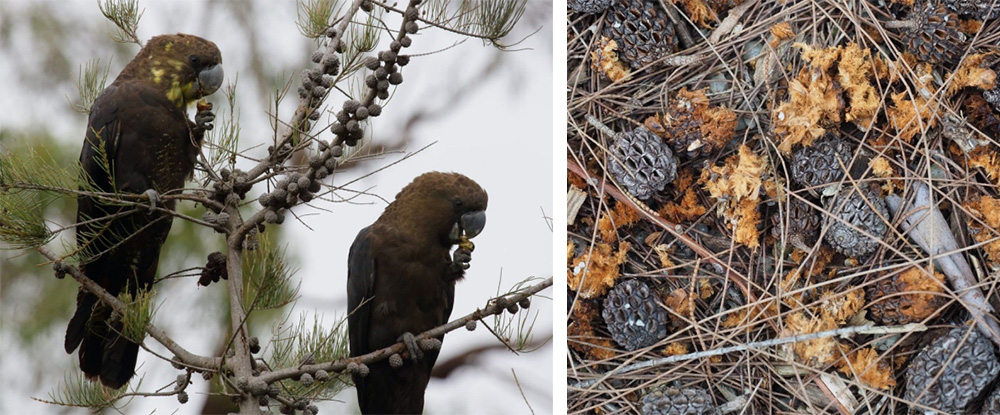
Key findings:
- Before the fires, signs of feeding were recorded at 37.8% of sites.
- Shortly after the fires (2-3 months) feeding was recorded at 38% of unburnt sites, but only 4.8% of burnt sites.
- Follow up surveys nearly 2 years after the fires found that feeding signs were still low in burnt areas (4.8% of sites) and, concerningly, drastically declined to 14% of sites in unburnt areas .
- Population recovery is dependent on how quickly the resprouting Black Sheoak take to mature and produce cones and protection of remaining feeding stands.
DEECA’s Gippsland Monitoring, Evaluation and Reporting program for bushfire management continues to monitor the species with the assistance of the Birdlife East Gippsland volunteers.
Publications
- Biodiversity response and recovery supplementary report: bushfire impacts on species in Victoria August 2022 (Accessible version (DOCX, 5.7 MB)
For more information, contact belinda.rossack@deeca.vic.gov.au
Recovery actions
Aquatic animal rescues
For freshwater aquatic species, rainfall after bushfire events can be lethal. Rain can wash ash, debris and sediment into waterways, which can suffocate or bury species. Chemicals used for fire suppression might also be washed into waterways, contaminating the water and potentially killing vulnerable species.
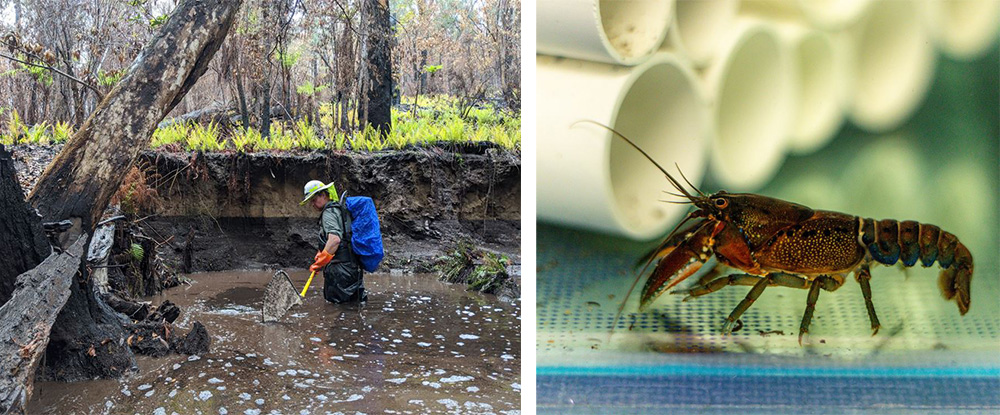
Key actions:
- Moved Macquarie Perch from fire affected sites in the Buffalo River to nearby rivers and to the Victorian Fisheries Authority hatchery at Snobs Creek (see video on DEECA Hume facebook page).
- Moved Murray Cod in the Ovens River upstream to areas unaffected by fire.
- Rescued galaxiid fish, crays and mussels from the wild and temporarily housing them at the ARI aquarium facility. This has included Dargo Galaxias, East Gippsland Galaxias, Yalmy Galaxias, McDowalls Galaxias, East Gippsland Spiny Crayfish, Orbost Spiny Crayfish, Arte Spiny Crayfish and Depressed Freshwater Mussels.
- Glenelg Freshwater Mussels rescued from a fire affected area in South West Victoria were also extracted and housed at the ARI aquarium.
- Aquatic fauna rescued from the wild were returned to their original homes in September 2020.
For more information contact: jarod.lyon@deeca.vic.gov.au
Additional media:
- 'Going home - threatened aquatic species return to East Gippsland', made in conjunction with Parks Victoria, shows ARI returning rescued aquatic fauna to streams in East Gippsland.
- 'Rescuing threatened aquatic species after the East Gippsland bushfires'
Research impact
ARI’s research following the Black Summer Fires have:
|
For further information on the 2019/2020 bushfire biodiversity recovery program across Victoria visit Victoria’s bushfire emergency: Biodiversity response and recovery
For information on the impacts of the 2009 Victorian bushfires bushfire visit Natural Values Recovery Program following the 2009 bushfires.
Page last updated: 08/07/25